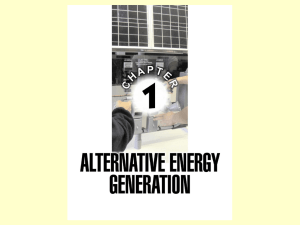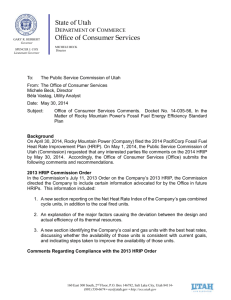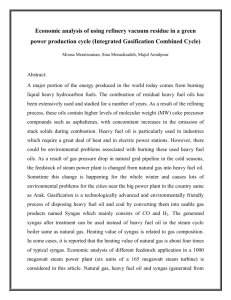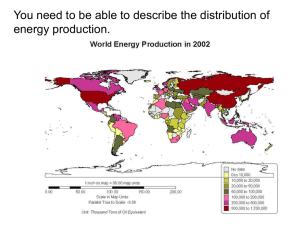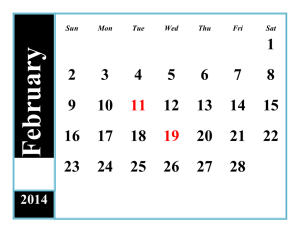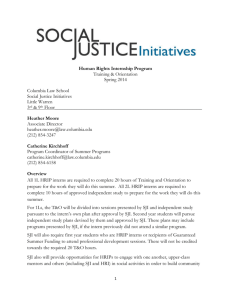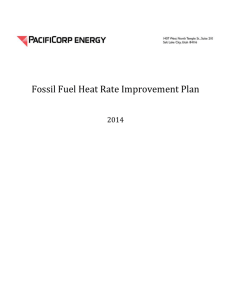Comments from DPU - Utah Public Service Commission
advertisement
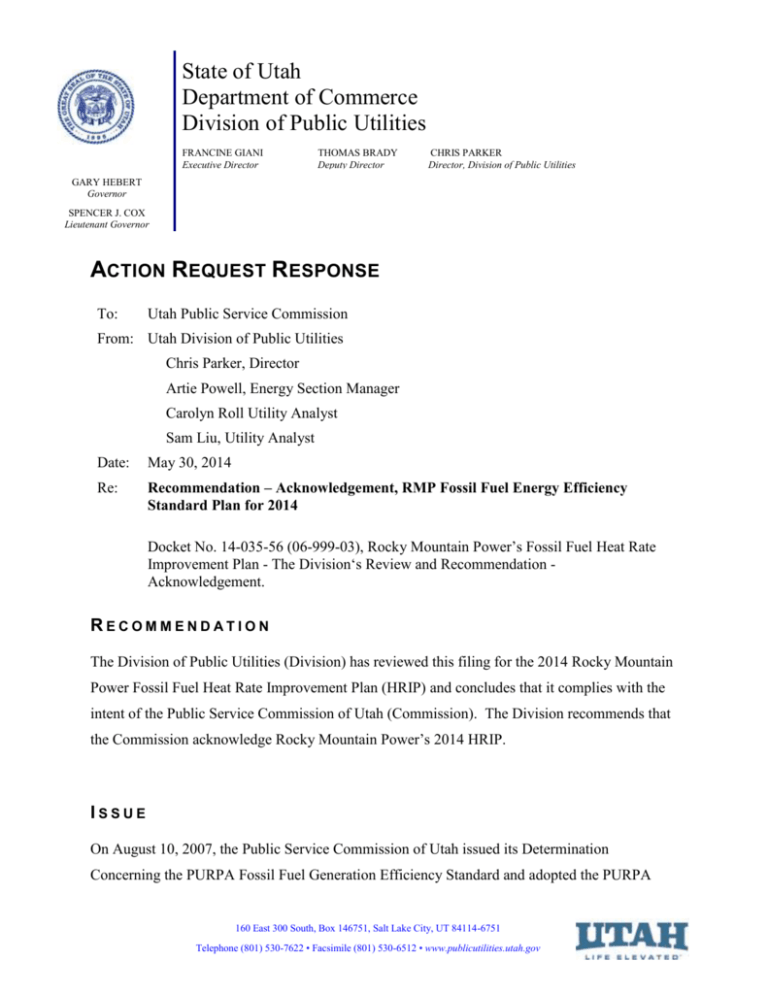
State of Utah Department of Commerce Division of Public Utilities FRANCINE GIANI Executive Director THOMAS BRADY Deputy Director CHRIS PARKER Director, Division of Public Utilities GARY HEBERT Governor SPENCER J. COX Lieutenant Governor ACTION REQUEST RESPONSE To: Utah Public Service Commission From: Utah Division of Public Utilities Chris Parker, Director Artie Powell, Energy Section Manager Carolyn Roll Utility Analyst Sam Liu, Utility Analyst Date: May 30, 2014 Re: Recommendation – Acknowledgement, RMP Fossil Fuel Energy Efficiency Standard Plan for 2014 Docket No. 14-035-56 (06-999-03), Rocky Mountain Power’s Fossil Fuel Heat Rate Improvement Plan - The Division‘s Review and Recommendation Acknowledgement. RECOMMENDATION The Division of Public Utilities (Division) has reviewed this filing for the 2014 Rocky Mountain Power Fossil Fuel Heat Rate Improvement Plan (HRIP) and concludes that it complies with the intent of the Public Service Commission of Utah (Commission). The Division recommends that the Commission acknowledge Rocky Mountain Power’s 2014 HRIP. ISSUE On August 10, 2007, the Public Service Commission of Utah issued its Determination Concerning the PURPA Fossil Fuel Generation Efficiency Standard and adopted the PURPA 160 East 300 South, Box 146751, Salt Lake City, UT 84114-6751 Telephone (801) 530-7622 • Facsimile (801) 530-6512 • www.publicutilities.utah.gov DPU Action Request Response Docket No. 14-035-56 Fossil Fuel Generation Efficiency Standard with a due date of March 31 each year. On November 25, 2010, the Commission modified the filing schedule to May 1 each year. As directed in Commission Order dated July 11, 2013 in Docket No. 13-035-69, Rocky Mountain Power (Company) met with Commission staff and interested parties on January 29, 2014, to receive further input on the plan. On April 30, 2014, in accordance with Commission order, the Company filed its Fossil Fuel Energy Efficiency Standard Plan or Heat Rate Improvement Plan. On May 1, 2014, the Commission issued a Notice of Filing and Comment Period, with comments due on or before May 30, 2014 and reply comments may be submitted on or before June 16, 2014. This memorandum represents the Division’s response to the Commission’s Notice of Filing. DISCUSSION In regards to HRIP 2014 report, the Company has developed the attached plan which is intended to provide more useful information focused on key heat rate improvement initiatives. The 2014 plan includes Company owned and operated combined cycle gas plants. Fossil fuel generation fleet efficiency can be improved by following three main activities; 1- Maintaining an emphasis on the continuous improvement of existing generating fleet efficiency. 2- Adding new fossil fuel generation with improved efficiency. 3- Retiring old and less efficient fossil units. Factors Effecting Optimum Heat Rate: 1. System efficiency losses due to equipment degradation: Turbine: Deposition, Solid Particle Erosion, Mechanic Damage, Internal Seal Leakage, Cycle Isolation, and Non-Recoverable Losses. -2- DPU Action Request Response Docket No. 14-035-56 Boiler: Dry Gas Losses, Excess Air, Fuel Properties, Air Heater Seal Leakage, Boiler Tube Surface Fouling, and Casing Leakage. Condenser: Condenser Pressure, Cooling Water Inlet Temperature, Heat Load, Circulating Water Flow, Tube Fouling and Air-in Leakage. Feedwater Heaters: Feedwater Heater Out of Service. 2. Controllable Losses: Main Steam Pressure and Main Steam Temperature: Main steam temperature is one of the most important of the operator controllable parameters relating to heat rate. Hot Reheat Temperature: As with main steam temperature, a higher temperature yields higher steam enthalpy and more energy available to the turbine. Reheat and Superheat Spray Flows: Reheat and superheat spray flows have different effects on unit performance, both increase heat rate and unit output. Excess Air: The additional amount of air will carry the part of combustion heat to increase the exit gas temperature. Maintaining the proper exit gas temperature is a balancing act. Condenser Pressure: A decrease in condenser pressure improves turbine efficiency and output. Final Feedwater Temperature: Lower feedwater temperature to the economizer requires additional fuel to raise the water in the boiler to the saturation point. Auxiliary Steam Flow: Auxiliary steam flow from a lower pressure location in the turbine train is typically more efficient than extraction from the boiler area because power is provided in the high pressure turbine section while reducing the pressure to the required steam supply conditions. Auxiliary Power: Auxiliary power affects the amount of electricity that is available at the switchyard for sale. -3- DPU Action Request Response Docket No. 14-035-56 3. Dispatch: The figure of Typical Heat Rate vs Load Curve, on page 10 of 32, shows heat rate normally increases with lower loads. If a unit is dispatched to a lower load due to any system condition, then unit efficiency will decrease. Heat Rate Management Process: Heat rate or thermal efficiency of the thermal generating units is affected by many factors including fuel quality, unit original design, load profile, unit operation, unit maintenance, weather, system conditions, and economics. The overall objective of heat rate management is to maintain the best possible unit heat rates given changing factors. The Company’s heat rate management and improvement is based on the following key principles and concepts: 1. An emphasis on operating as near optimum efficiency as practical given fuel quality and maintenance schedules. Control software has been installed to help operators assess the efficiency impact of sub optimal operation on a real time basis. 2. Units that are not dispatched at maximum output should always be operated in a manner that results in the lowest heat rate. 3. The load profile of each unit is dictated by the economic dispatch of the generating units to meet the system load. 4. Unit and equipment performance is monitored on a continuous basis where practical. 5. Design upgrades to existing units when they become available through improved technology. Economically justified improvements are incorporated into the capital budget and unit overhaul plans. 6. Consistent heat rate reporting is essential for budgeting and regulatory requirements and is coordinated at the corporate level. 7. Good feedback on the unit heat rate and equipment performance is essential for plant personnel to control and manage heat rate. -4- DPU Action Request Response Docket No. 14-035-56 8. Unit heat rate will tend to become optimized as plant personnel increase their knowledge of equipment performance and testing. The discussion of heat rate management in the HRIP is primarily from a coal plant perspective, if there are specific problems and mitigation measures for the CCCTs, the Division requests that those are included in future reports. Maintenance Overhaul The efficiency of generating units, primarily measured by the heat rate degrades gradually as components wear over time. During operation, controllable processes are adjusted to optimize the unit’s power output compared to its heat input. Turbine, boiler and balance of plant improvements contribute to improved efficiency and increased availability, and are included during planned overhauls. The Division requests that future plans include expanded discussion of the controllable parameters referenced on page 11 of the report under Heat Rate Management and Improvement. Heat Rate Index The Commission’s Order, dated July 11, 2013, directed the Company to provide the calculations of the “Heat Rate Index.” As shown in the report, the Heat Rate Index is the ratio of the actual measured Heat Rate divided by the designers calculated Heat Rate (adjusted for deviations from design boundary conditions). In the HRIP a heat rate index is calculated for each power generation unit by measuring the actual total fuel energy burned during the period (BTU) and dividing this by total net product output for the period (kWh). The resulting value is then divided by the design heat rate adjusted for the external boundary conditions such as the ambient air temperature, pressure, ambient relative humidity, fuel temperature, and fuel constitutes. This section also provides an explanation of the major factors causing the deviation between the design and actual efficiency of its thermal resources. -5- DPU Action Request Response Docket No. 14-035-56 This 2014 HRIP report includes a summary of the 2013 FERC Form 1 data and 10 year summary data (2004 ~ 2013). The Table and two charts on page 22 of 32 represent both 10 year historical and 10 year forecast heat rates for each of the PacifiCorp owned and operated plants. CONCLUSION The Division has identified a few items to be addressed in future plans. Therefore, the Division recommends that the Commission direct the Company to address these concerns in future Heat Rate Improvement Plans. The Division also recommends that the Commission direct the Company to meet annually with interested parties prior to February 1 to discuss format and content of the HRIP. CC Dave Taylor, Rocky Mountain Power Michele Beck, Office of Consumer Services -6-



